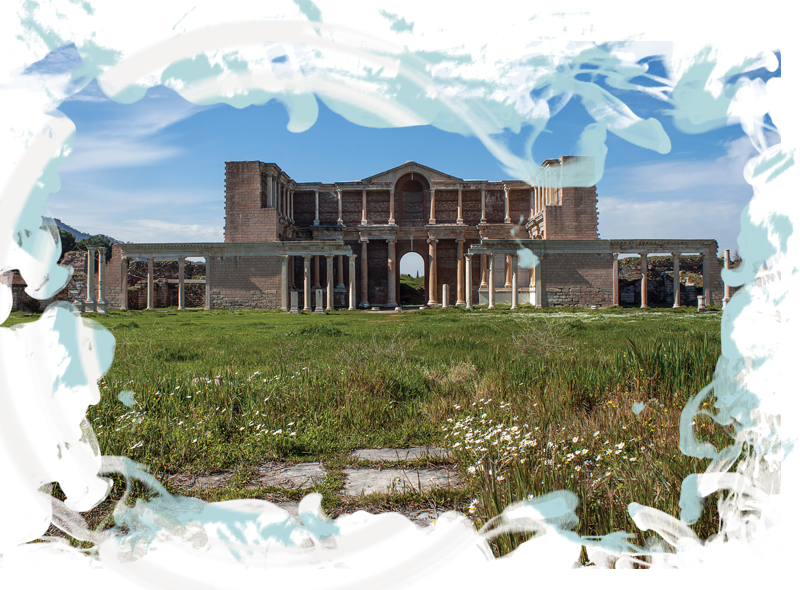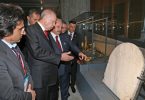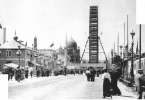Established on the foothills of Spil Mountain on the northeast of Izmir Bay, ancient Lydia capital Sardis now within Manisa city limits, is known as the city where the first coin in the history was made. City, referred to as the “golden city” by father of history Smyrnian Herodotus, became famous as the beauty center of ancient age.
Textiles in various colors, assorted perfumes in tiny bottles and curative salves were widely produced and used here. Sardis Ancient City near Sart town in Salihli district, was acknowledged in the past as an entertainment center as well as a beauty and care city. Lydians invented numerous mind games played even today to entertain their guests visiting from all corners of the world. Dice, an essential instrument of various traditional games and primarily backgammon, was used for the first time in Sardis.
ON ROYAL ROAD
In Bintepeler in the immediate vicinity of Sardis archaeological site, Lydian king tombs named “tumulus” are situated. The Croesus Treasure, Turkey retrieved from the USA in recent years, was discovered in one of these mausoleums regarded as authentic Anatolian pyramids. King of great Lydian Civilization Croesus is defined as world’s wealthiest man in ancient documents. A most dynamic trade route of ancient age, Royal Road beginning in Iran and Mesopotamia would enter Sardis lands. Lydians owed all their wealth to controlling this trade route connecting Anatolia to Mediterranean. This is why they made the first coin, and hosted the first tourists that visited Sardis by sea. The invention of money took place as follows: Due to intense trade activity in the region, the need for a material to use in trade arose. At first various metal bars and rings were employed in trade. However later, coins made of precious metals were used, stamped by the state to guarantee their weights and purity. Capital Sardis is known as a cosmopolitan city of the ancient age. City was populated with those visiting either for trade purposes or out of curiosity. The beauty of this city enchanted people so much that notables of the city were almost considered saints.
ANDALUSIA OF ANATOLIA
Today Sardis resembles a coil of traces of numerous civilizations. Archaeologists have ceaselessly been working since 1958 to unravel the ancient mysteries of the city. One of the most extensive restoration works in Turkey has been conducted as part of the project. Gymnasion dating back to Roman era and Anatolia’s oldest synagogue have already reclaimed their original forms. Visitors of the archaeological site are welcomed by the uniquely fine entrance gate of Gymnasion. Giant mosaics covering Synagogue’s floor stand out with the rich variety of patterns. Thousands of small rocks were assembled in a way to form meaningful shapes as vine leaves, geometrical series and animal figures. Bronze House across Gymnasion is thought to belong to a high priest due to numerous sacred bronze works. There is a Byzantine monastery, a stadium and an amphitheater nearby. Acropolis is located on a steep hill. Another structure worth seeing in Sardis is the Temple of Artemis. Built around 300 B.C. temple is a characteristic example which demonstrates the changes city went through. An Artemis Alter was there before the temple. A church was built here as well in years when Christianity was on the rise. Sardis referred to as one of the seven churches in west Anatolia which played an important role in Christianity spreading to Western world as mentioned in “revelation” section of the ‘Holy Bible’, is of great significance for religion. The variety of sacred spaces in the region indicates that people of different faiths managed to peacefully live side by side for centuries. Sardis is thus referred to as the Andalusia of Anatolia.
CITY OF PRINCES
It would be a pity not to visit Manisa when visiting Sardis. Manisa referred to as “city of princes” because of the educational institutions where sultans were once raised in, is worth seeing as it hosts elegant examples of Ottoman architecture. The most remarkable one is undoubtedly Muradiye Mosque. This historic sanctuary in Sultaniye district was built in Sultan Murad III period. Designed as a social complex by Mimar Sinan, the construction of the Mosque was commenced in 1583 and completed in two years. The structure in classical Ottoman architectural style with two minarets was built with ashlar stones. Right next to the sanctuary decorated with eye catching tiles, are madrasah and hospice. Today, one of the two largest cities in Aegean region alongside Izmir, Manisa fell under the rule of Hittites, Phrygians, Lydians, Romans, Byzantines, Saruhanoğulları and Ottoman throughout the history. Saruhan Bey, known to be the grandson of a Khwarizmian khan, declared Manisa as the capital. Saruhan Bey who expanded the lands of the city, established a navy and launched expeditions to Greek coasts and Central Thrace. He allied with beylics and states in the region, and thanks to Navy’s spoils, the economy was recovered and Manisa developed a Turkish-Islamic identity with the mosques, madrasahs, monasteries, lodges and libraries built. And natural beauties of the city… The summer ranges on foothills of the legendary Spil Mountain Manisa leans back on, offers a rich variety of endemic plant and animal species including infamous Manisa tulip. Atalanı (Horse Grounds) on the road to the summit is famous with jades. This grounds, photographers and people with a passion for horses visit for observation, awaits you.
HOW TO GO?
The most practical way to visit Sardis is to fly to Izmir. Izmir can be reached by regular flights from Istanbul, Ankara and Antalya, and is only 39 kilometers to Sardis. You may reach Sardis over Manisa either by taking a bus at Izmir bus terminal or by renting a car at the airport









Leave a Comment